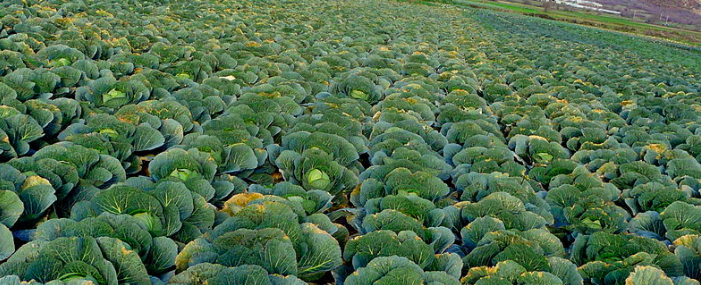
The first cabbage.
Cauliflowers, kale, Brussels sprouts, cabbages, roe cabbages, all these varieties come from a single species, wild cabbage Brassica oleracea .
Although China is the world’s largest producer of cabbage, wild cabbage is actually native to South-West Europe – it is still found in France in Nord-Pas-de-Calais, Poitou-Charente and especially in Basse Normandy.
The natural environment of this wild cabbage – also called cabbage cliffs ! – are the littoral zones of pebbles, dunes and cliffs . It gives a little idea of the growing conditions that it prefers: drained soil, regular rainfall and airy climate . It must meet fewer slugs in the dunes than in our gardens 😉
These are biennial plants.
What does it mean? Well, the first year they grow in vegetation, constitute a stock of energy that serves them second to flower and resemerate before withering. In the natural environment of cabbage, it is rather an advantage, because resemer often allows to adapt to lands which change rapidly with the erosion.
In the garden, it has advantages and disadvantages.
The major disadvantage is that it lengthens the culture of cabbages, which instead of hurrying to bloom the first year, wait for the second. The advantage is that they can withstand the cold winter , and therefore be grown also in autumn and winter .
When do cabbages grow according to variety?
A little bit all the time, actually … because the different local domestication of Brassica oleracea gave varieties with very different rhythms.
We do not harvest the same part of the plant according to the variety: sometimes leaves – kale , cabbage , others flowers – cauliflower , broccoli , romanescos cabbage – the buds – Brussels sprouts or the stem – cabbage .
Oh yes, we forgot the ornamental cabbage that you can buy in the fall at the florist.
For the details of each crop, click on the links above – they take you straight to the growing sheets in Groww, our free gardening help app – just put the cabbage you’re interested in as a “project”, and Groww will remind you to sow , transplant , water , when the time is right! And to go to bed less stupid, you can take a look at page 16 of this PDF on the domesticated plant that explains in detail where the main varieties come from.
Plant the cabbage.
Contrary to what the song says, there is only one way to plant cabbage: using a picnic 😉
Joke aside, considering what is written above on the original climate wild cabbage, you may suspect that they prefer the well drained soils , even stony, limestone , full sun , and the great sea air , which is wet. As a bonus, they are reputed to empty the soil of its nitrogenous compounds , and do not appreciate fresh organic matter. Take a ride on Tela Botanica to learn more.
Gestures to please little sprouts: when planting, bury the seedlings until the first leaves. If the collar of your plants is nibbling regularly, suspect the stonefish : a cardboard on the ground around each plant prevents females from going to lay eggs.
In cabbage, there is only good … provided you do not overcook it.
Cabbages are rich in trace elements and vitamins , but many fear them – especially cauliflowers – for having experienced difficult digestions. In addition to the high sulfur content that gives cabbage a characteristic odor, they contain indigestible sugars that form during cooking and promote the formation of gas. The mixture of both is necessarily: 1: explosive, and 2: odorous.
Cooking is crucial: do not cook too long , and blanch them 10 minutes before boiling water before cooking. The other option is not to cook them at all, which works very well 😉
Magic: cabbage leaves are equipped with automatic cleaning.
The leaves are self-cleaning thanks to their hyper-hydrophobic properties! They are covered with wax and small asperities that run water on their surface very quickly, which causes particles … It is convenient to stay clean, to keep effective photosynthesis, or to shelter from the rain 😉
In case of big problem in the garden, bank attack or nuclear disaster, provide your best cabbage with a cloak ! Why ? Because:
We assure you that all the people who participated in this joke – yes, they put themselves in several – were asked to leave the office for several minutes as a result of their mischief.
Why does it happen too often to white cabbage?
Well, we are not going to hide the face: cultivate cabbage outside areas with mild and coastal climate is a random bet . Depending on the climate, they can be invaded by their different parasites – flies, butterflies, slugs – which benefit from the fact that we cultivate them outside the “ecological optimum”.
Moist and heavy soil favors slugs, good availability of nitrogen helps the growth of leaves … and aphids , while a too dry climate – Mediterranean – makes them dry out. These are natural phenomena in the natural garden, we must encourage the presence of auxiliaries enormously , avoid too much grouping his plants, and plant more to compensate for the losses caused by these handicaps.